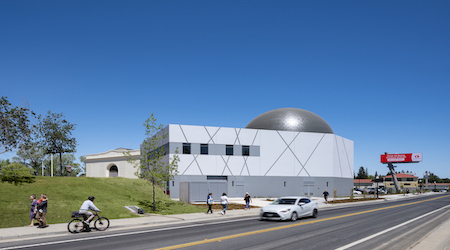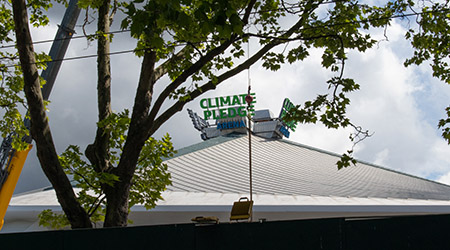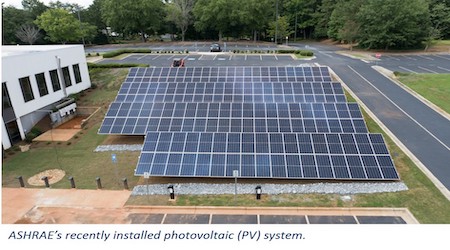
Kyle Jeffers Photography, courtesy RHEINZINK
Case Study: New Planetarium Dome Showcase Zinc Roof Tiles
November 15, 2021
A hemispheric dome, clad in more than 1,500 RHEINZINK-prePATINA graphite-grey flat-lock tiles, prominently crowns the new planetarium's roof at Sacramento Municipal Utility District (SMUD) Museum of Science and Curiosity (MoSaC, pronounced "moe-sack"). In September, it was honored with a 2021 Best Real Estate Projects of the Year award by the Sacramento Business Journal.
MoSaC's new facility is set on 5.38 acres overlooking the Robert T. Matsui Waterfront Park. Demonstrating its commitment to natural and built environments, the museum is pursuing LEED Gold certification through the U.S. Green Building Council for its energy-efficient, sustainable design and construction.
Conceived and realized by the Sacramento-based team of Dreyfuss + Blackford Architecture (D+B) and Otto Construction, the iconic design/build project reimagines a historic riverfront power station as a hub for science education, exploration and advancement in the Sacramento region.
Part of a redevelopment plan in downtown Sacramento, the $83 million museum is housed within the 30,000-square-foot structure of a 1912 power station. A Landmark building listed on the National Register of Historic Places; the Pacific Gas & Electric Company's Power Station B has remained vacant since it was decommissioned in 1954. At one time, it was the largest power plant north of San Francisco.
Fully renovated and expanded, MoSaC allows ample space for STEAM – science, technology, engineering, art and math – programming and exhibits. The new two-story, 22,000-square-foot addition contains the museum's classrooms, offices, a café and the 120-seat planetarium.
Natural Fit
The planetarium's domed addition required a base steel ring positioned exactly at a 5-degree tilt and 5-degree rotation, according to Otto Construction. The dome's roof consists of structural steel, double light-gauge metal framing walls, a layer of fiberglass mat gypsum roof cover boards, and two layers of plywood covered by RHEINZINK AIR-Z matting and prePATINA graphite-grey zinc tiles.
Sheet Metal Supply, Ltd. (SMS) provided specialty contractor Rua & Son Mechanical with approximately 3 tons of 0.8mm RHEINZINK-prePATINA graphite-grey architectural zinc with factory-applied RHEINZINK ProRoofing backside coating, plus the structured matting. Rua & Son fabricated and installed 1,570 tiles to clad the dome.
"As a RHEINZINK systems partner, we make sure the material is available and in stock, so we always have what our customers need," said Lisa England, project manager at SMS.
SMS vice president, Ben Kweton, CSI-EP, agreed and added, "We strive to make sure the customers have a great experience with RHEINZINK. We partner with our clients throughout the process to make sure they have all the tools they need for a successful installation. The [MoSaC planetarium] is a wonderful example of this symbiosis."
To ensure an accurate, aesthetically pleasing result, Rua & Son Mechanical teamed with RHEINZINK and Otto early in D+B's design of the planetarium's roof. "About a year before there were boots on the ground, we were meeting with the architect and Otto to review what zinc can and cannot do, what colors are available and other considerations," said Louie Rua, president of Rua & Son Mechanical.
"The design called for metal with a natural look. Painted metal looks painted. Zinc delivers the natural look and patina, and its soft pliability takes the shape of the roof better and really hugs the curve," explained Rua.
Smooth and Symmetrical
Rua noted that his team and RHEINZINK also offered recommendations to avoid "oil canning," where the metal surface looks wavey and uneven. "This can be more noticeable depending on the size of the panel, the thickness of the metal material, and any inconsistencies in the dome's construction and underlying surface."
"Each row is a little different," observed Rua. "First, we used CAD to visualize the layout on the screen. Then, we worked with Otto to build a 20-by-20-foot physical mock-up that replicated the dome about half-way up. These models allowed us to play with the panels' thickness, sizes and dimensions. This helped us make sure they didn't oil can and were not too small at the top or bottom."
To maintain an overall symmetrical appearance, the zinc panels were trapezoid shaped and uniformly proportioned for each row, but were sized larger at the bottom of the dome and smaller at its top. SMS provided coils of 0.8mm RHEINZINK-prePATINA graphite-grey, which Rua's team then precisely fabricated as custom-sized, custom-tapered panels under factory-controlled conditions.
"We put Elias Valencia, our shop foreman for over 20 years, on this project. Using our computerized folding and shearing equipment, he made every one of those panels – from the 32-by-18-inch ones on the bottom of the dome to the 9-by-18-inch ones on the top," praised Rua.
He continued, "The panels then went to two of our most experienced zinc guys in the field, Robert Kahaunaele and Anthony Sullivan, who have installed many tons of zinc over the years. Because access was challenging, they often worked off a 135-foot-tall boom lift. They worked together in sequence, row by row, from bottom to top. At the end of the row, a specially formed, interlocking panel zips them together at the back so everything matches. Otto paid careful attention to the dome's construction. The zinc panels went on flat and tight for a smooth, symmetrical appearance. It turned out great."
Rua added, "We like to take on these trickier projects. We've been doing zinc for about 15 years and have done a large number of projects with RHEINZINK."
Next
Read next on FacilitiesNet












